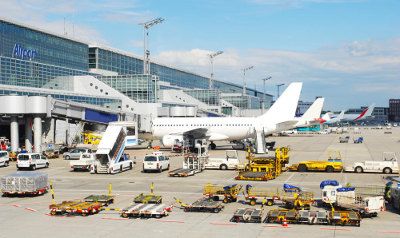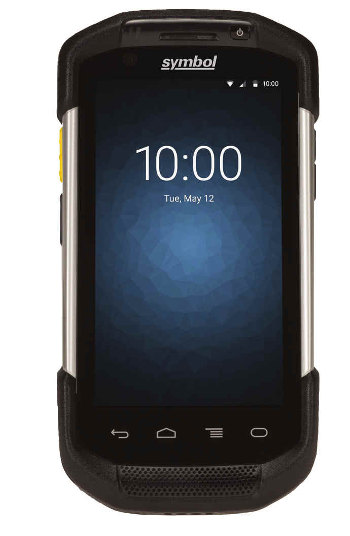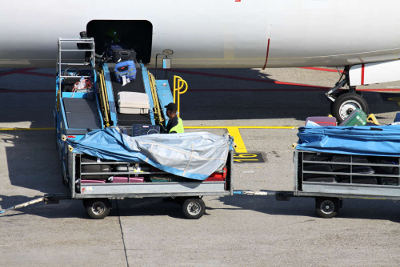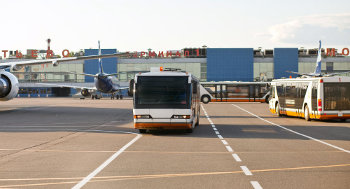TARSYS aero-quip a modular IT system for mobile data applications at airports. It also meters the handling and execution of bus, apron and baggage services.
TARSYS aero-quip comprises both hardware and software components designed for the capture and management of on-site apron services rendered at airfields. It can be used as an integrated mobile component in modern airport management and baggage guidance systems. Group masters, baggage masters, apron buses and other apron vehicles are normally all equipped with mobile devices. These receive job orders from a central control point via wireless radio modem, capture data or job status by means of the mobile devices and send these back to the central point.
The leaders of all the teams deployed on the airport apron are equipped with mobile devices. Staff registration is necessary prior to using the application.
The handling tasks are transmitted to the relevant mobile devices by the airport management system scheduler. The orders transmitted contain all the important flight information and sub tasks for each member of the team, including instructions for the beginning and end of their deployment. Changes in status are also captured and sent to the central software, so that the schedulers are kept abreast of job progress at all times.
The services rendered are also recorded. Aircraft-related service packages which are continually being rendered and subsequently billed are prescribed in advance. Additional services can also be captured. The previously set values for the given services are captured either in the time domain or as meter readings. This allows the services to be fully and equitably billed in respect of the various airline companies. Billing is only therefore carried out for those services which are actually rendered.
Other function keys allow data relating to baggage, post, cargo and dangerous goods to be collected.
SITA notifications can also be received.
Malfunctions are reported by selecting the appropriate fault cause function button.
A text function, in which incoming texts trigger an audible signal, enable the scheduler to stay in text contact with the team leaders.
Data capture can be continued even where the data link has been broken. Any data stored in the mobile device is transmitted to the central control point once the radio link has been restored. This ensures that no data is lost.
The baggage application for the mobile device supports baggage handling procedures. Deploying the application enables the deployment leader to coordinate baggage handling staff economically and efficiently.
Once the user has logged in, he is asked to scan a barcode containing the aircraft number.
The user can then process up to 4 tasks simultaneously:
- Sort out the stowage area
- Drive the baggage container away
- Miscellaneous tasks
- Take a break
Driving jobs are divided between the available buses, such that a seamless transportation service is provided. The mobile application supports the driver whilst he is behind the wheel allows the scheduler continuous control over job implementation.
Tasks are assigned by radio communications and displayed on the mobile device fitted into the bus. The driver is able to see all the tasks allocated to his bus in the job template, but is able to see only the relevant data of the upcoming task.
A large switching area is used for forwarding job status. The following conditions exist:
- Job accepted
- Arrival at start location
- Commence boarding
- Boarding completed
- Arrival at final destination
- Commence disembarkation
- Job completed
The immediate transmission of job status to the central control point keeps the scheduler fully updated on the progress of the bus.
Special GPS function
Following adoption of Schengen handling procedures, it is vital to ensure that the two different security level passenger flows (the Schengen / non-Schengen flows) are at no point allowed to come together in the security area. The application uses GPS tracking to ensure that passenger buses do not stop at the wrong gate.
The application is given the position of the bus by the GPS receiver mounted in the vehicle and compares it with the zones (geofences) of the gates towards which the vehicle is driving. If the bus is heading for the wrong gate, the driver immediately receives a visual and audible warning signal.
Arrival at the wrong gate prevents job status alterations being implemented (e.g. arrival, disembark) and the status changes may only then be made following acknowledgement by the driver of a warning prompt. In this case, a warning signal is also received by the scheduler.
Malfunctions are reported by selecting the appropriate fault cause function button.
A text function, in which incoming texts trigger an audible signal, enable the scheduler to stay in text contact with the team leaders.






